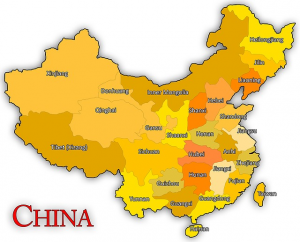
China and Corona Virus will be forever linked in our minds. However, there is another important connection that we should be making: selenium status and its effect on COVID-19 virus in China.
Let me explain. Chinese and American and British researchers have published a letter in the American Journal of Clinical Nutrition in which they report evidence of a significant association between regional selenium status and the reported cure-rate of COVID-19 infected patients in China [Zhang 2020].
The researchers’ data show a statistically significant association between the reported cure-rates for COVID-19 virus infections and selenium status in China [Zhang 2020].
The Selenium Status and COVID-19 Cure-Rate
Beginning in mid-February 2020, the researchers collected data from the Baidu website, which they describe as a non-governmental website that provides daily updates of reports from the health commission of each province in China.

The researchers defined cure-rate and death-rate as the percentages of COVID-19 infected patients who were cured or who died.
They used the National Health Commission of China definition for “cured patients.”
- The patient’s temperature has returned to normal for more than 3 days.
- The patient’s respiratory symptoms are significantly improved.
- The patient’s lung imaging shows significant reduction of inflammation.
- The patient’s test for respiratory pathogens shows negative on 2 consecutive occasions at least 1 day apart.
The researchers analyzed the associations between regional and city cure-rates and mean regional and city hair selenium status.
Data from Inside Hubei Province (capital city: Wuhan)
The death-rate was significantly higher and the cure-rate significantly lower in Hubei Province than in all other Chinese provinces. Consequently, the researchers decided to do two separate analyses: one for inside Hubei Province and one for outside Hubei Province.
Notably, the data for Hubei Province show that the cure-rate in Enshi City – a seven-hour drive to the west of Wuhan – was much higher than the cure-rate for other cities in Hubei Province. Enshi City is in a region that is known for its very high selenium intakes and selenium status, higher than in other parts of Hubei Province.
Data from Outside Hubei Province (capital city: Wuhan)
The researchers’ analysis of the data from Heilongjiang Province in northeast China, a notoriously selenium-poor region in which Keshan County is located, showed a much higher death-rate for this low-selenium region compared to other Chinese provinces outside Hubei Province.
The researchers also found significant associations between selenium status and cure-rate in cities outside Hubei Province.
They did not do a correlation analysis for cities inside Hubei Province because selenium status data were available for only two cities in the province.
Explaining the Association between Selenium Status and Cure-Rate
To explain why high selenium status is associated with higher cure-rates and lower death-rates, the researchers pointed to earlier work by the Melinda Beck laboratory:
- Beck showed that host selenium deficiency was associated with the increased virulence of RNA viruses such as coxsackie virus B3 and influenza virus A [Beck 2004].
- Viral infection of a selenium-deficient host resulted in the mutation of the virus to a more virulent form than was the case in selenium-sufficient hosts [Beck 2004].
The researchers also pointed to the evidence from Keshan County, the site of seasonal outbreaks of Keshan disease. Keshan disease is a selenium-deficiency disease that results in congestive cardiomyopathy (a form of heart muscle disease). Keshan disease is caused by a combination of selenium deficiency and infection by a mutated strain of the coxsackie virus.
In 2018, Zhou et al published a meta-analysis of 41 studies including 1,983,238 subjects, 683,075 of whom were in experimental groups and 1,300,163 of whom were in control groups. The data from the studies showed that giving selenium supplements to the residents of the Keshan disease endemic areas significantly reduced the incidence of Keshan disease [Zhou 2018].
Possible Limitations of the Selenium Status and COVID-19 Cure-rate Study
The researchers admit that there may be confounding variables at work for which they did not have data in their study of the influence of selenium deficiency on COVID-19 cure-rates and death-rates in China [Zhang 2020]:
- age
- co-morbidities such as heart disease, diabetes, hypertension, chronic respiratory disease, and cancer
- variations in medical treatment facilities from region to region
- variations in therapy protocols from region to region
Bottom line: Selenium Status and COVID-19 Cure-Rate in China
- Studies have shown that host selenium deficiencies are associated with increased virulence of coxsackie viruses and influenza viruses [Beck 2004].
- Selenium deficiency is associated with the pathogenicity of several viruses. Several selenoproteins, in particular the glutathione peroxidases and thioredoxin reductases, seem important in various models of viral replication [Guillin 2019].
- A new study shows that there is a significant association between selenium status and COVID-19 virus cure-rate in China [Zhang 2020].
Sources
Beck MA, Handy J, Levander OA. Host nutritional status: the neglected virulence factor. Trends Microbiol. 2004; 12:417–23.
Guillin OM, Vindry C, Ohlmann T, Chavatte L: Selenium, Selenoproteins and Viral Infection.; Nutrients 2019 11 2101
Rayman MP. Selenium intake, status, and health: a complex relationship. Hormones (Athens). 2019; 19(1): 9-14.
Zhang J, Taylor EW, Bennett K & Rayman MP. Association between regional selenium status and reported outcomes of COVID-19 cases in China. Amer J Clin Nutr. 2020; 1-3.
Zhou H, Wang T, Li Q & Li D. Prevention of Keshan Disease by selenium supplementation: a systematic review and meta-analysis. Biol Trace Elem Res. 2018 Nov; 186(1): 98-105
The information present in this review article is not intended as medical advice and should not be used as such.
31 May 2020
